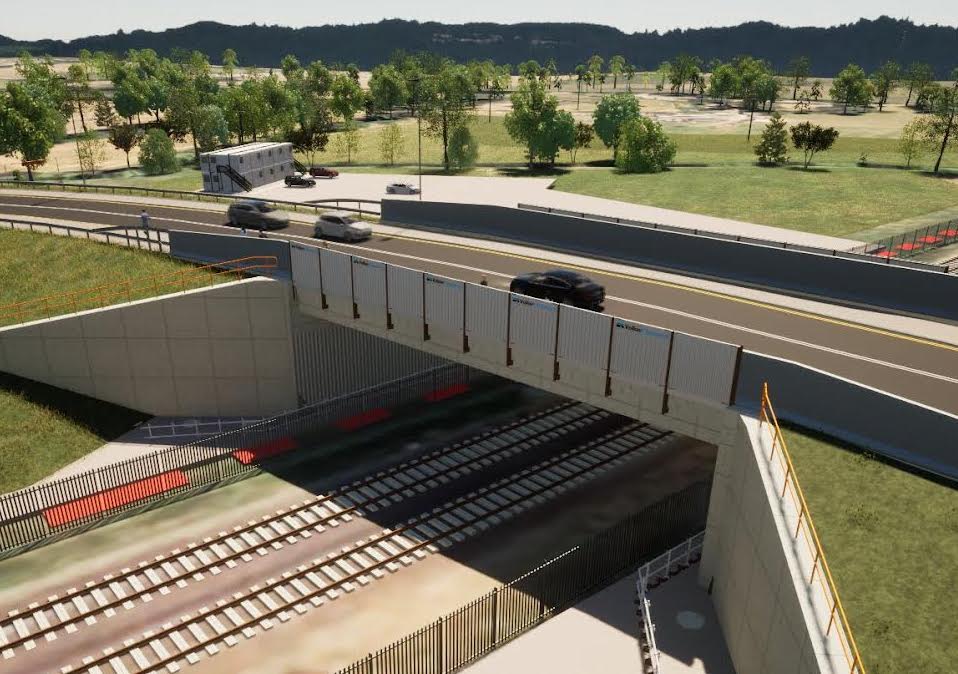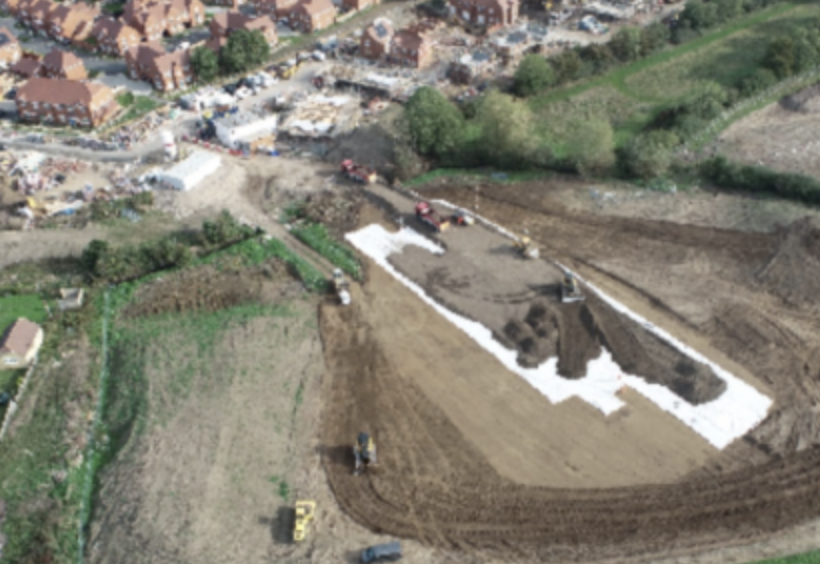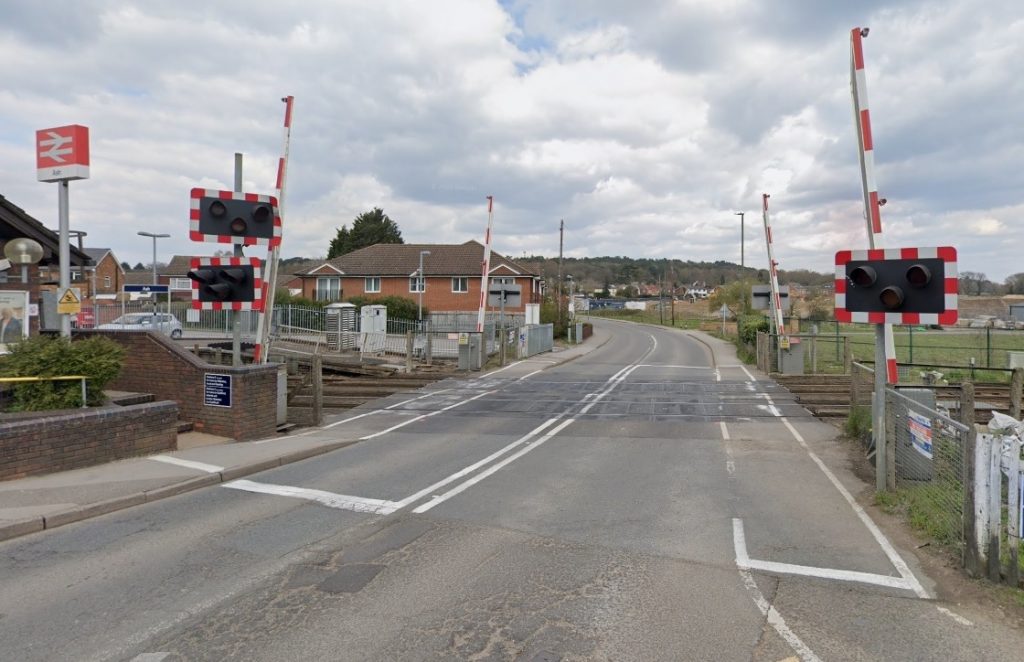 Abraham Lincoln
If given the truth, the people can be depended upon to meet any national crisis...
Abraham Lincoln
If given the truth, the people can be depended upon to meet any national crisis...
 Guildford news...
for Guildford people, brought to you by Guildford reporters - Guildford's own news service
Guildford news...
for Guildford people, brought to you by Guildford reporters - Guildford's own news service
Ash Road Bridge: Detailed Analysis Shows ‘Long-Term Cost Could Soar’
Published on: 28 Feb, 2024
Updated on: 28 Feb, 2024
By David Reading
The cost of the Ash Road Bridge could grow to as much as £110 million, according to a new examination of the finances – more than double the £44.5 million total cost claim most recently reported by Guildford Borough Council.
But the council has stuck by its £44 million total cost forecast.
The original estimated cost was just £15 million but recently disclosed project information is said to show a huge increase long-term, based on rising borrowing costs and maintenance costs.
The findings have been revealed by local campaigners, who spent many hours over the past six years going through GBC papers, making Freedom of Information requests and completing a detailed cost analysis.
The investigation was undertaken by John Ferns, a Tongham resident of 35 years standing, and borough councillor Sue Wyeth-Price (R4GV, South Ash), a former IT outsourcing consultant.
Mr Ferns has a background in finance and has worked informally with the residents’ associations of the Ash area.
GBC did not explain why they disputed the findings, but said in a brief statement: “After six months of on-site construction, the project is currently forecasting the final cost of building the Ash Road Bridge to be within the £44 million capital budget.”
The bridge scheme – which was intended to facilitate the closure of Ash level crossing – was approved overwhelmingly by GBC planners in early 2021 and debated for some years before that.
Those councillors in favour have always maintained that building a bridge over the railway line will successfully address the traffic congestion that builds up at Ash Station. This in itself has been questioned by some campaigners, who believe the traffic problems may simply be transferred to other parts of Ash.
The figure of £110 million has been calculated by Mr Ferns based on official papers on the budget for the bridge, published in March 2023. These were confidential at the time but were obtained by Mr Ferns at the end of 2023 by means of a Freedom of Information request (FoI).
The papers state:
 The borrowing costs already approved in April 2021 were £797,000 per annum for Stage 1 (road bridge) and Stage 2 (footbridge). However, the cost of borrowing has increased since April 2021, alongside the budget. The increase in borrowing costs as a result of the revised budget is anticipated to be £459,000 per annum to the annual General Fund revenue account. It is anticipated that borrowing will be either from the UK Infrastructure Bank or the Public Works Loan Board. The MRP cost will be effective from 2025/26 (the year after the bridge becomes operational). Interest will be effective from when the loan is taken out.
The borrowing costs already approved in April 2021 were £797,000 per annum for Stage 1 (road bridge) and Stage 2 (footbridge). However, the cost of borrowing has increased since April 2021, alongside the budget. The increase in borrowing costs as a result of the revised budget is anticipated to be £459,000 per annum to the annual General Fund revenue account. It is anticipated that borrowing will be either from the UK Infrastructure Bank or the Public Works Loan Board. The MRP cost will be effective from 2025/26 (the year after the bridge becomes operational). Interest will be effective from when the loan is taken out.
The worst-case scenario will therefore result in an annual charge to the General Fund revenue account of £1.256 million plus the annual estimated maintenance cost of £50,000 for the next 50 years.
Using these statements about rising borrowing costs – and adding on maintenance costs – Mr Ferns has calculated what he believes to be the real cost of the bridge, long-term: about £110 million.
GBC declined to release one confidential paper, a decision Mr Ferns has asked to be reviewed. His argument is that there is a need for the fullest public disclosure, given the fact that the decision to go ahead with the bridge project was made just before the borough elections in 2023, when 33 of the 48 councillors changed, and before the more recent reports of mismanagement within council finances were revealed.
Mr Ferns said councillors, many of whom might be unfamiliar with the financial background, need to be especially critical when they come to consider the considerably greater risks associated with the Weyside Urban Village project.
Cllr Wyeth-Price said: “One of the major issues is the unpublished total cost of the bridge which is outlined in the exempt papers obtained by John through an FoI. The total costs are obviously the published £44.5 million but you have to add on the unpublished sums. These are £50,000 per annum for maintenance costs plus the newly revised borrowing costs of £1.3 million per year, both for a period of 50 years. These figures no longer include the Dover Arms roundabout (built by developers) or the footbridge, which may not now go ahead.
“This is a total of £65.3 million which, together with the £44.5 million, amounts to £109.8 million. The annual cost is equivalent to 14 per cent of the annual council tax revenue that GBC retained from its residents in 2023/24.
“We have indebted our children and grandchildren to that much for no demonstrable benefit, based on what we now believe to be false information.”
This allegation of incorrect information relates, in part, to the question of how much public support there is for the bridge.
Cllr Wyeth-Price said: “In order to obtain the first Homes England Grant of £10 million for the bridge, GBC had to submit a statement demonstrating strong local community support for the scheme. GBC refused to provide details of this statement, so an FoI request was made to Homes England.
“This showed that the sole contents of the statement were three letters, all on GBC-headed paper, stating the individuals’ support for the bridge. There were no comments from any other officers, councillors, stakeholders, or residents.
“There have always been claims that the ‘vast number of residents support the bridge’. Primarily these claims came from a former borough councillor, Nigel Manning, and present councillor Fiona White. Both have claimed that there was a petition to close the crossing in 2004. This is simply not true.
“There was a petition raised by residents of Ash Street in 2003, which was presented at the Guildford Local Committee in November of that year and discussed at committee in January 2004. The petition requested action on four traffic issues. None of these involved the Ash Station crossing.
“Nine traffic calming measures were proposed as a response to the petition, none of which included any works near or around the crossing. Only three of these included any proposals for permanent traffic features. These were traffic calming in Shawfield Road and the pelican crossing in Ash Church Road. The Aldershot Road cycle path was never delivered.
“A second petition, this time in support of the bridge, was organised by then parish councillor Ed Schofield. Over two years between July 2019 and 2021 this was widely publicised, many times, on the four local social media sites, reaching – I would estimate – an audience of well over 7,000 unique users. It garnered only 41 signatures.”
GBC’s statement to The Guildford Dragon NEWS did not address this allegation relating to public support, but a further brief statement did say Cllr White had nothing to add. Nigel Manning, who is an Ash parish councillor, has not responded so far to our request for comment.
An allegation of incorrect information also relates to the amount of time the crossing gates are actually closed. Based on Network Rail’s response to another FoI request, Cllr Wyeth-Price has challenged the figures presented by GBC, saying these were inaccurate and gave the impression that the traffic problems at Ash Station were more of a nuisance than they actually were.
Fears that the bridge may bring “no demonstrable benefit” have been voiced numerous times over the past five years.
On numerous occasions, The Guildford Dragon has reported concerns about traffic flow resulting from the building of the bridge.
Specific locations of concern that have been voiced by people include:
- Traffic coming from the Aldershot direction relies currently on gaps in the traffic created by the barrier closure to pass the parked cars along Ash Street. These gaps will not be available and the traffic could queue back beyond the Greyhound roundabout.
- Traffic coming from the Ash Church Road direction approaching the new Foreman Road roundabout will have to give way to traffic coming from the Ash Green direction. Rush-hour traffic could back up along the A323, just as it currently does.
- Grange Road. Here, traffic could increase considerably as drivers living on the new Ash Lodge Park Estate would look for a shortcut to the new bridge, thus avoiding the junction taking them on to the A323.
- Ash Hill Road. Traffic approaching the “Dover Arms” roundabout would have difficulty finding a gap in the traffic to turn left. Although the level crossing undoubtedly causes traffic problems, at least traffic turning left can find a gap easily when the gates are closed.
Responses to Ash Road Bridge: Detailed Analysis Shows ‘Long-Term Cost Could Soar’
Leave a Comment Cancel reply
Please see our comments policy. All comments are moderated and may take time to appear. Full names, or at least initial and surname, must be given.Recent Articles
- Council Reorganisation: What We Propose ‘Will Not Make a Jot of Difference’ Says Councillor
- Letter: See How the Bluebells Have Been Damaged
- Ash Vale Residents Call For Firm Action To Stop Catapult Attacks on Canal Wildlife
- Flashback: Stoughton Recount Completes Borough Council Results
- Notice: Art Exhibition – May 31
- Letter: Council Should Take Action Against Department Store Owners
- Strikes to Cause Disruption at Gatwick Airport
- Mayor’s Diary: May 12 – May 20
- From ESL Classrooms to Equine Therapy: Moira’s Unlikely Path to Psychotherapy
- Highways Bulletin May 12 – New ‘School Street’ Opens


Recent Comments
- Dave Middleton on Tree Felling Has Caused ‘Stomach-churning’ Distress, Parish Council Told
- Patricia McClure on Tree Felling Has Caused ‘Stomach-churning’ Distress, Parish Council Told
- Lee Jarrett on Memories Of Queen Elizabeth Barracks And The Women’s Royal Army Corps
- C Scott on Where Is This? No.204
- Rachel Buckett on Memories Of Queen Elizabeth Barracks And The Women’s Royal Army Corps
- Brian Creese on Guildford Has a New Mayor with Rock Star Quality
Search in Site
Media Gallery
Dragon Interview: Local Artist Leaves Her Mark At One of England’s Most Historic Buildings
January 21, 2023 / No Comment / Read MoreDragon Interview: Lib Dem Planning Chair: ‘Current Policy Doesn’t Work for Local People’
January 19, 2023 / No Comment / Read MoreA3 Tunnel in Guildford ‘Necessary’ for New Homes, Says Guildford’s MP
January 10, 2023 / No Comment / Read More‘Madness’ for London Road Scheme to Go Ahead Against ‘Huge Opposition’, Says SCC Leader
January 6, 2023 / No Comment / Read MoreCouncillor’s Son Starts Campaign for More Consultation on North Street Plan
December 30, 2022 / No Comment / Read MoreCounty Council Climbs Down Over London Road Works – Further ‘Engagement’ Period Announced
December 14, 2022 / No Comment / Read MoreDragon Interview: GBC Reaction to the Government’s Expected Decision to Relax Housing Targets
December 7, 2022 / No Comment / Read MoreHow Can Our Town Centre Businesses Recover? Watch the Shop Front Debate
May 18, 2020 / No Comment / Read More














John Ferns
February 28, 2024 at 4:34 pm
This is an extraordinarily complacent response from GBC who are seemingly choosing to ignore the implications of borrowing so much money. And this is even before the massive Weyside Urban Village project is factored in.
I draw their attention to this extract from a government paper published last year on Local authority capital financing which offers this guidance on “a code of prudential borrowing”
“…There is some flexibility in exactly how individual local authorities set these limits. The Prudential Code does not prescribe formulae for the exact calculation of prudential limits, so it is not possible to say definitively that an authority has calculated its limits correctly or incorrectly. The Code permits the authority to rely on the judgement of the local authority chief finance officer, and on ‘generally accepted accounting practices’.” (See: https://researchbriefings.files.parliament.uk/documents/SN05797/SN05797.pdf)
The minutes of the full council meeting of 16 March 2023 reveal that wide ranging concerns were expressed by those present, however, less than two months later, 33 of the 48 Cllrs were to lose their seats. (See:https://democracy.guildford.gov.uk/mgAi.aspx?ID=11598)
Given the scale of the financial mismanagement that has recently been revealed there is every reason to be concerned. Searching questions need to be asked by the current body of councillors.
Bibhas Neogi
February 28, 2024 at 8:29 pm
This road is a re-routing of the A323 and so should be the full responsibility of Surrey County Council.
GBC took the responsibility of building it (I believe to expedite house building in Ash under the Local Plan).
The highway authority is still Surrey County Council, so why is it that GBC has to finance its maintenance?
Peter Rafano
March 2, 2024 at 8:12 am
Regarding the issue of cars being unable to pass parked cars on Ash Street, this is primarily due to customers to the Co-Op. The plan to move this business to the old Police Station, which has ample space for a car park yet keeps being rejected, would alleviate this issue.